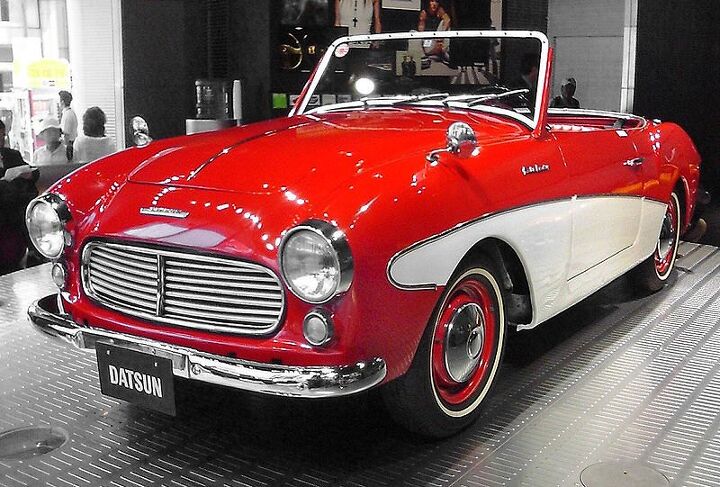A Pictorial History: The World's First Metrosexual Car. Fair Lady At Home, Mister Z When Away

In the 80’s, I took a sabbatical from marketing and propaganda, and managed a record distribution company in the U.S. My warehouse manager was Rick, a redheaded bear of a guy who also could have been Master at Arms of the local Hells Angels chapter. Come to think of it, he managed the parts department of a motorcycle store before I hired him. The love of his life were a motor cycle and his Z Car. Rick would have suffered a heart attack, would he have known that his manly Z was a ladyboy. At home in Japan, the Z had a girlie name : The Fairlady.
The first Fairlady was the Datsun SPL212. Only a few hundred were built of the 47 hp roadster from 1960 through 1962. The car received its fairy moniker from the hit musical My Fair Lady. The car was made for the export market only, and in the U.S., the Fairlady name was ignored.
The Fairlady had sisters in rapid succession. In 1962, a more serious sports car followed in form of the Fairlady 1500, a roadster with 85 horses, and a transistor radio as standard equipment. On the way to the U.S., the lady had a sex change, and went to market as the Datsun 1500.
The Fairlady 1600 underwent the same transformation from 1965 through 1070: Lady in Japan, 1600 elsewhere.
The Fairlady 2000, or its more manly pendent, the Datsun 2000, was a more serious matter. With the competition package, the 2 liter engine could produce 150 hp, and the car hit 140 mph on a good day or on the SCCA racetrack.
The car rose to worldwide stardom when the Nissan Fairlady Z was launched in 1969. Again, there was a metamorphosis on the way to the U.S., and instead of a Fairlady, a Z Car rolled off the boat. The car was made in several versions and with several engines. With over 2 million cars sold, it holds the record as the best-selling sports car of all times. It also maintained an important tradition: Fairlady at home, no lady elsewhere.
Likewise little known is the fact that the metrosexual car spawned another revolution: The female product specialist. Tokyo started to buzz when it was selected for the 1964 Summer Olympics. Japan’s post-war economic miracle went into high gear.
At the Ginza in downtown Tokyo, a tower went up, and in the tower was the Nissan gallery.
Nissan’s tower, left. Volkswagen’s tower, right
The gallery concept influenced flagship showrooms the world over. The tower idea found its way to Germany. When Volkswagen opened its Autostadt in 2000, it had two towers.
To attract visitors, Nissan used a tried and true technique: Beautiful women. Except this time, the ladies had to do more than just stand around and be beautiful. The ladies received product training.
A competition was held, and after several rounds of interviews, five candidates were chosen as the first class of Nissan Miss Fairladys. Were the ladies named after the car, or the car after the ladies? We’ll never know.

Bertel Schmitt comes back to journalism after taking a 35 year break in advertising and marketing. He ran and owned advertising agencies in Duesseldorf, Germany, and New York City. Volkswagen A.G. was Bertel's most important corporate account. Schmitt's advertising and marketing career touched many corners of the industry with a special focus on automotive products and services. Since 2004, he lives in Japan and China with his wife <a href="http://www.tomokoandbertel.com"> Tomoko </a>. Bertel Schmitt is a founding board member of the <a href="http://www.offshoresuperseries.com"> Offshore Super Series </a>, an American offshore powerboat racing organization. He is co-owner of the racing team Typhoon.
More by Bertel Schmitt
Latest Car Reviews
Read moreLatest Product Reviews
Read moreRecent Comments
- ToolGuy 9 miles a day for 20 years. You didn't drive it, why should I? 😉
- Brian Uchida Laguna Seca, corkscrew, (drying track off in rental car prior to Superbike test session), at speed - turn 9 big Willow Springs racing a motorcycle,- at greater speed (but riding shotgun) - The Carrousel at Sears Point in a 1981 PA9 Osella 2 litre FIA racer with Eddie Lawson at the wheel! (apologies for not being brief!)
- Mister It wasn't helped any by the horrible fuel economy for what it was... something like 22mpg city, iirc.
- Lorenzo I shop for all-season tires that have good wet and dry pavement grip and use them year-round. Nothing works on black ice, and I stopped driving in snow long ago - I'll wait until the streets and highways are plowed, when all-seasons are good enough. After all, I don't live in Canada or deep in the snow zone.
- FormerFF I’m in Atlanta. The summers go on in April and come off in October. I have a Cayman that stays on summer tires year round and gets driven on winter days when the temperature gets above 45 F and it’s dry, which is usually at least once a week.











































Comments
Join the conversation
Did the "Fair Lady" branding actually parallel a women-centric marketing effort? Or were the buyers mostly men in Japan?
That Nissan/Mitsubishi tower is pretty iconic of the Ginza in particular and Tokyo in general. The hallways appear to be quite narrow, though...I guess you could not show a Hummer there...